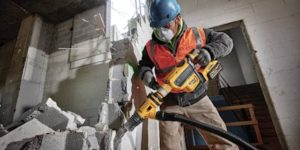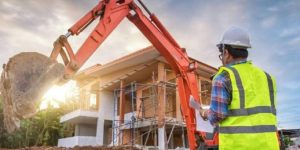Tools for Demolition -Learn Safe and Effective Dismantling
Introduction

In the world of construction and renovation, demolition is an inevitable and crucial stage. It’s a task that demands precision, strength, and the right set of tools. In this blog post, we’ll delve into the Tools for Demolition, ensuring you have the knowledge and resources for a successful demolition project.
Introduction to Demolition Tools
Demolition isn’t just about tearing things down recklessly. It’s a careful process that requires specific tools for efficiency and safety. From heavy-duty machinery like excavators to handheld tools like hammers, each tool has a role to play.
Types of Demolition Tools
Heavy-Duty Equipment
Jackhammers
These powerful tools are essential for concrete demolition and other hard materials. They deliver high-impact force, making them ideal for foundational and road demolition tasks.
Excavators
Known for their versatility, excavators can be used for a variety of demolition tasks. Equipped with different attachments, they can demolish structures, clear debris, and even sort materials for recycling.
Bulldozers
Bulldozers are great for clearing large areas and pushing debris. They are commonly used in site preparation and can quickly demolish smaller structures like sheds or houses.
Handheld Tools
Sledgehammers
Perfect for smaller demolition tasks, sledgehammers provide the brute force needed to break walls, remove tiles, and dismantle fixtures.
Crowbars
These tools are essential for prying materials apart and removing nails or fixtures. Their leverage ability makes them invaluable for both demolition and renovation.
Reciprocating Saws
These saws are versatile tools for cutting through wood, metal, and plastic. They are particularly useful for dismantling structures where precision cuts are necessary.
High-Tech Tools
Demolition Robots
These remote-controlled machines are ideal for working in hazardous or confined spaces. They offer precision and reduce the risk to human operators.
Concrete Crushers
Used for breaking down large pieces of concrete, these crushers are often mounted on excavators for efficient processing of demolition waste.
Thermal Lances
For cutting through strong metals, thermal lances use high temperatures to melt and sever materials, often used in industrial demolition.
Safety Considerations in Demolition
Comprehensive Training
Beyond just wearing PPE, workers must be thoroughly trained in the correct usage of tools and safety protocols. This includes understanding the risks associated with each tool and the specific safety measures to mitigate them.
Risk Assessment and Planning
Before any demolition project begins, a detailed risk assessment should be conducted. This helps identify potential hazards and plan the demolition process to minimize risks, ensuring that all safety considerations are addressed.
Emergency Procedures
Establishing clear emergency procedures is crucial. Workers should be trained in first aid, evacuation plans, and emergency response protocols. This preparation can significantly reduce the impact of any unforeseen accidents.
Selection Criteria for Demolition Tools
- Tool Efficiency and Power: The efficiency and power output of the tool should match the demands of the project. Overpowered tools can be as detrimental as underpowered ones, leading to unnecessary risk or inefficiency.
- Ergonomics and User Comfort: Considering the ergonomics of the tool is vital for worker safety and productivity. Tools that reduce strain and fatigue can greatly enhance performance and reduce the risk of injury.
- Compatibility with Other Equipment: The selected tool should be compatible with other equipment used on the site.
Maintenance of Demolition Tools
- Regular Inspection and Testing: Regularly inspecting and testing tools ensures they are in proper working order. This includes checking for cracks, damages, and functionality issues.
- Proper Cleaning and Lubrication: Regular cleaning and lubrication of tools not only extend their lifespan but also maintain their efficiency. Accumulation of dust, debris, or rust can significantly impair a tool’s functionality.
- Storage and Handling Practices: Proper storage and handling of tools prevent damage and wear. Tools should be stored in dry, secure places and handled with care to avoid dropping or mishandling.
Future Trends in Demolition Tools
The future of demolition tools is exciting, with technological advancements making tools more efficient and safer. Look out for innovations in battery-powered tools and automation.
The Importance of Hiring a Professional Demolition Team

Demolition, despite the availability of various tools, is not always a DIY task. Here are key reasons to consider hiring a professional demolition team:
Expertise and Experience
Professional teams possess the expertise needed to handle complex demolition tasks. They have experience with a range of structures and materials, ensuring the right approach for each project.
Safety Compliance
Demolition can be hazardous. Professionals are trained to adhere to safety standards, minimizing risks. They are equipped with the necessary PPE and follow safety protocols rigorously.
Efficiency and Time Management
Professional demolition teams can complete tasks more quickly and efficiently due to their skill and experience. They understand the nuances of demolition timelines, ensuring project deadlines are met.
Proper Tool Usage
Professionals know precisely which tools for demolition are best suited for each aspect of the job. They have access to a wide range of specialized equipment, from jackhammers to excavators, which might not be feasible for individuals to obtain.
Legal and Environmental Considerations
Demolition involves legal requirements, such as permits and adherence to local regulations. Professional teams navigate these seamlessly. They are also better equipped to handle environmental concerns, ensuring sustainable practices.
Debris Management and Disposal
Post-demolition cleanup is a massive task. Professionals handle debris removal and disposal efficiently and responsibly. This includes recycling materials whenever possible, and aligning with eco-friendly practices.
Conclusion
Understanding the right tools for demolition is key to any successful demolition project. Whether you’re part of a demolition company, a DIY enthusiast, or a professional in the building industry, knowing your tools and how to use them safely and effectively is essential. Remember, the right tool not only makes the job easier but also ensures safety and efficiency. From building demolition tools to the best tools for demolition, your choice can significantly impact the outcome of your project. Keep an eye on the demolition tools and equipment list, and stay updated with the latest in this ever-evolving field.
At Rapid Demolition, we pride ourselves on being more than just a demolition company; we are your partners in ensuring that your project is executed with precision, safety, and efficiency. Choosing Rapid Demolition means partnering with a team that values quality, safety, and client satisfaction. We are dedicated to transforming your demolition projects into success stories, one building at a time. For more information or to discuss your next demolition project, visit us at Rapid Demolition. Let us help you build your future by skillfully tearing down the past.
